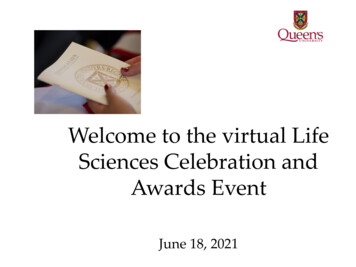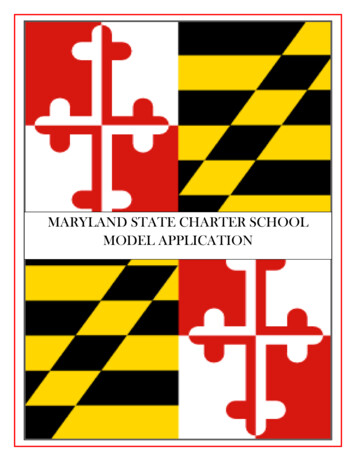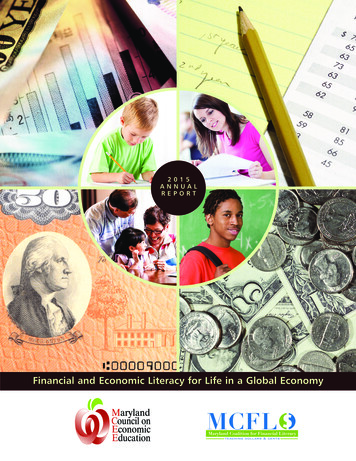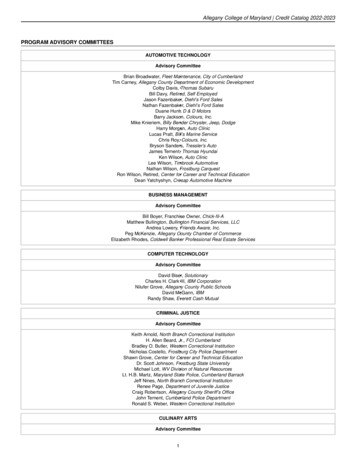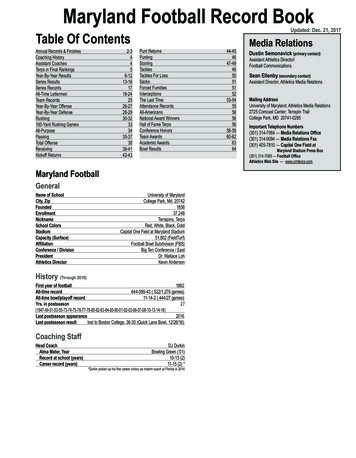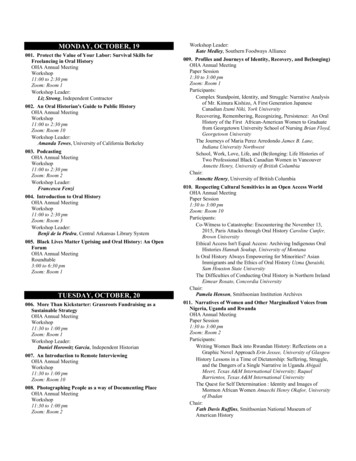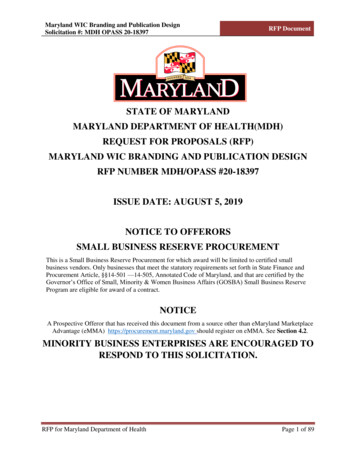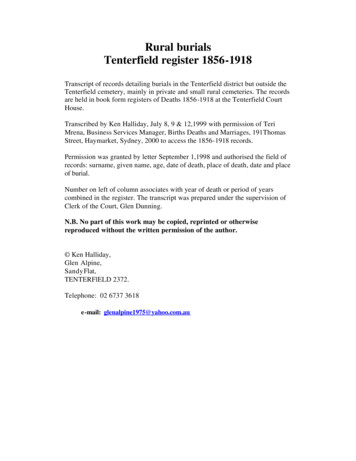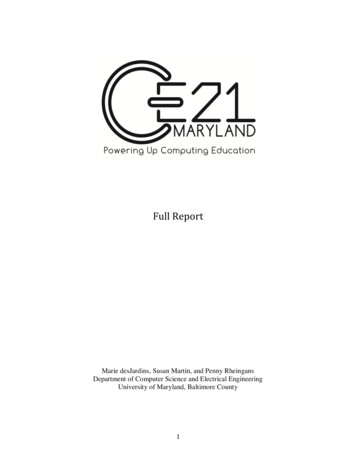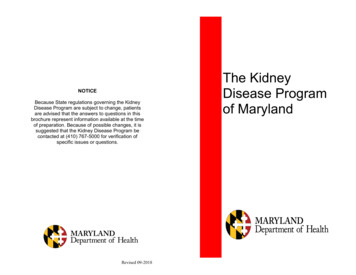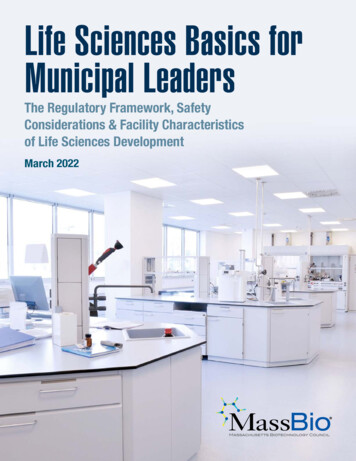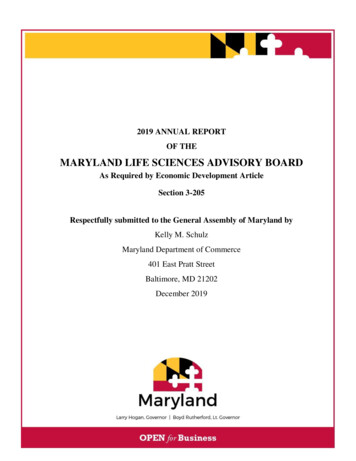
Transcription
2019 ANNUAL REPORTOF THEMARYLAND LIFE SCIENCES ADVISORY BOARDAs Required by Economic Development ArticleSection 3-205Respectfully submitted to the General Assembly of Maryland byKelly M. SchulzMaryland Department of Commerce401 East Pratt StreetBaltimore, MD 21202December 20191
IntroductionThe Life Sciences Advisory Board (LSAB) was established by Chapter 304, Acts of 2007, for thepurpose of maintaining Maryland’s preeminence in the life sciences industry. The function of theboard is to: Develop a comprehensive strategic plan for life sciences in the State of Maryland; Promote life sciences research, development, commercialization and manufacturing inMaryland; Promote collaboration and coordination among life science organizations in Maryland; Promote collaboration and coordination among research institutions of higher education inMaryland; Develop a strategy to coordinate state and federal resources to attract private sectorinvestment and job creation in the life sciences; Develop a strategy to support federal life sciences facilities located in the state, includingsupport for education, transportation, housing and capital investment needs; and Make recommendations to address critical needs in the life sciences, including access toventure capital and capital construction funding.In performing its duties, the LSAB is to give due consideration to the business, scientific, medical,and ethical aspects of the life sciences industry.Fiscal Year 2019 Board CompositionThe current LSAB was appointed by Governor Larry Hogan on February 13, 2016 to serve a twoyear term. The Board consists of the following members:Chair:Jay A. Perman, M.D., President - University of Maryland, BaltimoreVice Chair:Douglas Jon Liu, Senior Vice President, Head of Global Operations –Qiagen Sciences Inc.Appointed Members: Christopher P. Austin, M.D., Director, National Center for AdvancingTranslational Sciences – U.S. National Institutes of HealthCol. Andrea Stahl, Ph.D., Director, MRMC CBRN Defense MedicalResearch Coordinating Office and JPC-Radiation Health Effects - U.S.Army Medical Research & Material CommandFrank F. Weichold, M.D., Ph.D., Director, Critical Path and RegulatoryScience Initiatives, Office of the Commissioner – U.S. Food and DrugAdministrationRichard A. Bendis, President and CEO - BioHealth Innovation, Inc.David W. Smith, Ph.D., Vice President, Global Business Development,Emerging Technologies – Lonza Walkersville, Inc.William Hearl, President and CEO - Immunomic Therapeutics, Inc.Christy Wyskiel, Senior Advisor to the President and Head of JohnsHopkins Technology Ventures, Johns Hopkins UniversitySanjay K. Rai, Ph.D., Chief Academic Officer and Senior Vice President for2
Academic Affairs - Montgomery CollegeJarrod Borkat, Vice President, Corporate Strategy, Emergent BioSolutionsKaren L. Proudford, Ph.D., Associate Professor of Management andDirector, Graves Honor Program – Earl G. Graves School of Business &Management Morgan State University;President, William E. ProudfordSickle Cell Fund, Inc.Robert Storey, Principal, The MVR CompanyTheodore J. Olsen, President and CEO - PathSensors, Inc.Wendy Perrow, MBA, CEO - AsclepiX TherapeuticsStanding Member:Kelly M. Schulz, Secretary – Maryland Department of CommerceGeorge Davis, Chief Executive Officer – TEDCORecommendationsIn 2017, the Maryland Life Sciences Advisory Board issued the BioHealth Acceleration Initiative:Recommendations for Accelerating the Growth of the BioHealth Industry in Maryland. In 2019the LSAB remained focused on implementing on that set of recommendations. Below is anoverview of initiatives and actions that occurred during the year in support of thoserecommendations.Leverage and Grow Current Asset Base and Accelerate Commercialization Develop and implement the Maryland Medical Device GPS (Guidance, Prioritization,Support), an initiative to: Identify healthcare needs, and uses ‘market-pull’ information to drive innovation; De-risk investment, and accelerates development of new devices; Steward companies/technologies through Maryland’s MedDev ecosystem; Analyze data to identify where patient outcomes can be improved (i.e. hospitaladmissions reduced and/or cost of care reduced at entities such as the CMS,MHA, MDH, CareFirst); Form a Federal Task Force on Commercialization to support enhanced technologytransfer and commercialization from federal research labs. Support and contribute to NIST’s Green Paper on Tech Transfer from FederalLabs Support and contribute to Maryland Department of Commerce’s reports andlegislative initiatives Support U.S. Department of Commerce’s and the Federal Lab Consortium’sforums on transformational innovations and technologies.Increase Connectivity Among and Awareness of Maryland’s BioHealth Assets andResources Contribute to an innovative RFP to facilitate the private sector’s access to WRAIR’s PilotBioManufacturing Facility; Promote the BioHealth industry in Maryland and globally using a consistent brand andmessaging at trade shows such as: BIO 2019 International Convention AdvaMed MedTech Conference MEDICA 2019 Arab Health Trade Show3
Promote the BioHealth industry in Maryland and globally using a consistent brand andmessaging brand during international trade delegations with regions such as: United Kingdom Midlands Region Quebec, Canada Kanagawa, Japan Develop comprehensive Maryland BioHealth asset map and interactive web site (ongoing) Connect Maryland’s industry with federal resources, such as the Maryland Innovationand Technology Series taking place at the National Institutes of HealthIncrease Availability and Access to Capital for Early through Advanced Stage BioHealthCompanies Support the Emerging Maryland Asset Delivery Model Support local investment conferences, such as the BioHealth Capital Region InvestmentConference Advocate for the funding of existing State BioHealth financial programs Increase the connectivity between life science investors and the BioHealth startupcommunity Advocate for a fund to provide Small Business Innovation Research (SBIR) assistance toincrease win rate of non-dilutive capital and provide SBIR/STTR matching dollars(2019).Grow Talent Pool of Experienced BioHealth Entrepreneurs, Business Leaders, Graduatesand Scientists with Commercially Relevant Experience Enhancing entry-level pipelines from research institutions to industry, through programssuch as the Bridges to Biotech Program Engage with the Mid-Atlantic Biology Research and Career network (MABRC) andsupport its programming efforts Identify gaps and support programming to train C-Level entrepreneurs that are proficientin science & technology, and business4
Appendix 1 - LSAB Meeting MinutesMINUTESMEETING DATE: Friday, November 30, 2018TIME:LOCATION:1:00 P.M. - 3:00 P.M.The University of Maryland, Baltimore, Saratoga Building220 North Arch Street, Baltimore, MD 21201I.Welcome and IntroductionsII.Call to OrderJay Perman, M.D. - Chair, LSABPresident, University of Maryland, BaltimoreDr. Perman gave opening remarks. He introduced Secretary of Commerce Mike Gill.III.Message from the GovernorMike Gill - Secretary, Maryland Department of CommerceSecretary Gill, on behalf of the Governor and Commerce, summarized the strengths of theinnovation sector and updated group regarding the Excel Maryland Fund.IV.Review and Acceptance of May 15, 2018 Minutes.Minutes were reviewed and approved, as motioned by Dr. Perman.IV.Discussion - Maryland BioTechnology Tax CreditBen Wu - Deputy Secretary, Maryland Department of CommerceBen Wu gave an update on potential legislative initiatives impacting the MarylandBiotechnology Investment Incentive Tax Credit program. He reviewed how the tax programfunctions in the context of the 2017 legislative changes. He highlighted the uncertainty of theeconomic impact and the return on investment from the companies in the program. The programwas oversubscribed for the first time in 2017. He also summarized the findings from the series ofindustry meetings held across the State about how to best improve the program. A discussion ofinvestor uncertainty caused by the limited funds ensued. Senator King would like to change theprogram with the help of the LSAB, and the bill will likely be reviewed by LSAB. The team thenhighlighted recent successful companies that were aided by the tax credit. Jarrod Borkatsuggested that the program should include additional metrics to qualify QMBCs that outline aroadmap for business development.5
VI.Discussion - Working Group Updates:Jay Perman and Bret Schreiber introduced the LSAB working groups. Bob Storey summarizedthe goals and priorities of Working Group 1; Leverage and grow current Asset base andAccelerate Commercialization. Of note, the group is compiling a list of health priorities needsthat will be able to guide innovators so that inventions have a higher likelihood ofreimbursability by payers. The technology subcommittee of the FDA Testbed initiative will aidin developing the metrics required to pass the regulatory process and will be applying thosemetrics to novel technologies that participate in the testbed.Doug Liu summarized the work from Working Group 2; Increase Connectivity among andawareness of MD’s biohealth assets and resources. He introduced the WRAIR initiative,NIMBL, and the advertising efforts of Commerce. Bret Schreiber and Ernesto Chanonaexpanded on the WRAIR initiative, where companies have been invited to use the excesscapacity of their Pilot BioProduction Facility.Bret gave an update on Working Group 3; Increase availability and access to capital for earlythrough advanced stage BioHealth companies. The Maryland Asset Model was summarized.George Davis suggested that more partners would be necessary for optimal implementation ofthe Maryland Asset Model. Richard Bendis highlighted the BioHealth Capital Region InvestmentForum which was successful in attracting investors to the state. Bret emphasized that capitalinitiatives should continue to be led by the private sector.Bret gave an update on Working Group 4; Grow Talent Pool. Bret emphasized the need for atraining program to build C-level talent, but also the efforts of training entry-level programsthrough those such as the Biotechnical Institute of Maryland. He also mentioned the entry-leveldigital badging initiative from the UMD and community colleges, to help employers understandthe technical and soft skills attained by the graduates. Nina Lamba expanded on the Bridges toBiotech Program that helps post-docs acquire soft skills for biotechnology careers. A discussionon a C-level leadership program for life sciences, who have mid-level management experience,ensured. Steve Pennington suggested “Why Maryland” story will help in recruiting talent to thestate.Rich Bendis summarized the accomplishments of Working Group 5 - Task Force on FederalCommercialization Opportunities. He summarized the white paper “For the Competitiveness ofthe Nation and the Prosperity of the Region: Improving Technology Commercialization andLocalizing the Impact of Federal Laboratories in the Greater Washington Region.” Thereauthorization SBIR pilot programs will continue funding entrepreneurs-in-residence (EIRs),and the efforts of this working group with Maryland’s congressional delegation has added 5additional EIRs. The program at the NIH will allow access to companies that are further along intheir research to apply for Phase II funding. He also mentioned that Genetic Engineering rankedMaryland 4th in biotechnology cluster rankings in 2018. Bret re-capped the policy deliverablethat will include the input from U.S. Senate Committee on Small Business and Entrepreneurship,the LSAB and the Small Business Administration Technology Subcommittee. Jarrod Borkatsuggested we mitigate the risk of looking too region-specific by showing that Maryland is atemplate for federal programs that then be implemented in other states.6
VII.Discussion: LSAB Progress to Date - Annual Report HighlightsBret Schreiber, Senior Director, Office of BioHealth and Life SciencesBret provided a very brief overview of other key accomplishments from the Life Scienceindustry in Maryland. He discussed the Annual report on the activities of the LSAB for thepreceding fiscal year. Commerce’s report will update the progress from the April 2017 report,“BioHealth Acceleration Initiative - Recommendations for Accelerating the Growth of theBiohealth Industry in Maryland.” Bret then summarized other recent business successes andcompany recruitments efforts, including “Project Element” brining 800 new jobs to Frederick,the Viva White Oaks campus near the FDA, Boeing’s 3D Printing facility, and the FischellInstitute for Biomedical Devices.VIII. Next Steps - LSAB Vision for 2019 and Deliverables for 2018Jay PermanMike GillBret SchreiberDr. Perman then suggested the group meet again in February to outline concrete next steps for2019.IX. AdjournmentAttendees:Jay Perman, Chairman of LSAB, President, UMBDouglas Liu, Vice Chairman of LSAB, Senior VP of Global Operations, QiagenRich Bendis, President & CEO, BioHealth InnovationJarrod Borkat, Vice President, Corporate Strategy, Emergent BioSolutionsBill Hearl, CEO, Immunomic TherapeuticsTed Olsen, President, PathSensors, Inc.Wendy Perrow, President, AsklepiXSanjay Rai, Sr. Vice President, Montgomery CollegeBob Storey, Principle, MVRFrank Weichold, Director of Office of the Commissioner, US FDA7
Mike Gill, Secretary, Maryland Department of CommerceGeorge Davis, CEO, TEDCOCommerce Staff:Ben WuSteve PenningtonBrady WalkerBret SchreiberNina LambaErnesto ChanonaNot AttendingChris Austin, Director, NCATS, NIHLaurie Locascio, VP of Research, UMCPKaren Proudford, Professor of Management & Director of Graves Honor Program, MorganState UniversityDavid SmithChristy Wyskiel, Sr. Advisor to the President, Johns Hopkins University8
MINUTESMEETING DATE: Wednesday, June 19, 2019TIME:9:30 A.M. - 11:30 A.M.LOCATION:1:00 p.m.II.Rye Street Market13 Rye Street, Baltimore, MD 21230Welcome and IntroductionsCall to OrderJay Perman, M.D. - Chair, LSABPresident, University of Maryland, BaltimoreDr. Perman gave general opening remarks. He highlighted the focus of this meeting as arecap of activity since May 2018, and to provide for a discussion on how to beginvisioning for 2019. He stated that 2017 was for preparation of the Report; 2018 wasgeared toward “moving the needle” to implement action plans and recommendationsfrom the report. The purpose of the meeting was also for Working Groups to giveprogress reports on year to date activities.III.Message from the GovernorMike Gill - Secretary, Maryland Department of CommerceSec. Mike Gill gave remarks on behalf of the Governor and Commerce.IV.Review and Acceptance of May 15, 2018 MinutesIV.Discussion - Maryland BioTechnology Tax CreditBen Wu - Deputy Secretary, Maryland Department of CommerceBen Wu gave an update on potential legislative initiatives impacting the MarylandBioTechnology Tax Credit Program. He highlighted that commerce held a series ofindustry meetings across the State about how to best improve the program in Maryland.Ben Wu also talked about these activities and about getting the support of the LSAB forefforts to enhance the program during the 2019 Legislative Session of the MarylandGeneral Assembly.VI.Discussion - Working Group Updates:Jay Perman9
Each Working Group Chair spent 5 minutes providing an update on the progress of theworking groups to date, and held a 5 minute discussion. Working Group 1 - Leverage and grow current Asset base and AccelerateCommercialization - (Chair - Bob Storey) Working Group 2 - Increase Connectivity among and awareness of MD’s biohealth assetsand resources - (Chair - Doug Liu) Working Group 3 - Increase availability and access to capital for early through advancedstage BioHealth companies - (Chair - Wendy Perrow) Working Group 4 - Grow Talent Pool of experienced BioHealth entrepreneur’s, businessleaders, graduates and scientists with commercially relevant experience - (Chair - LaurieLocascio) Working Group 5 - Task Force on Federal Commercialization Opportunities (Chair Rich Bendis)VII.Discussion: LSAB Progress to Date - Annual Report HighlightsBret Schreiber, Senior Director, Office of BioHealth and Life SciencesBret Schreiber provided a very brief overview of other key accomplishments occurring inthe Life Science industry in Maryland. He explained that additionally, the Department ofCommerce is required to issue an Annual report on the activities of the LSAB for thepreceding fiscal year. Commerce’s report will update the progress from the April 2017report, “BioHealth Acceleration Initiative - Recommendations for Accelerating theGrowth of the Biohealth Industry in Maryland.”VIII. Next Steps - LSAB Vision for 2019 and Deliverables for 2018Jay PermanMike GillBret SchreiberIX.AdjournmentAttendees:Jay Perman, Chairman of LSAB, President, UMBDouglas Liu, Vice Chairman of LSAB, Senior VP of Global Operations, QiagenRich Bendis, President & CEO, BioHealth InnovationChris Austin, Director, NCATS, NIH10
Bill Hearl, CEO, Immunomic TherapeuticsTed Olsen, President, PathSensors, Inc.Wendy Perrow, President, AsklepiXLaurie Locascio, VP of Research, University of MarylandBob Storey, Principle, MVRFrank Weichold, Director of Office of the Commissioner, US FDAChristy Wyskiel, Senior Advisor to the President, Johns Hopkins University (Maybe)Ex Officio Members:Kelly Schulz, Secretary, Maryland Department of CommerceCommerce Staff:Kyle McColgenSigne PringleBret SchreiberErnesto ChanonaNot AttendingJarrod Borkat, Vice President, Corporate Strategy, Emergent BioSolutionsSanjay Rai, Sr. Vice President, Montgomery CollegeGeorge Davis, CEO, TEDCO11
Academic Affairs - Montgomery College Jarrod Borkat, Vice President, Corporate Strategy, Emergent BioSolutions Karen L. Proudford, Ph.D., Associate Professor of Management and Director, Graves Honor Program - Earl G. Graves School of Business & Management Morgan State University;President, William E. Proudford Sickle Cell Fund, Inc.
